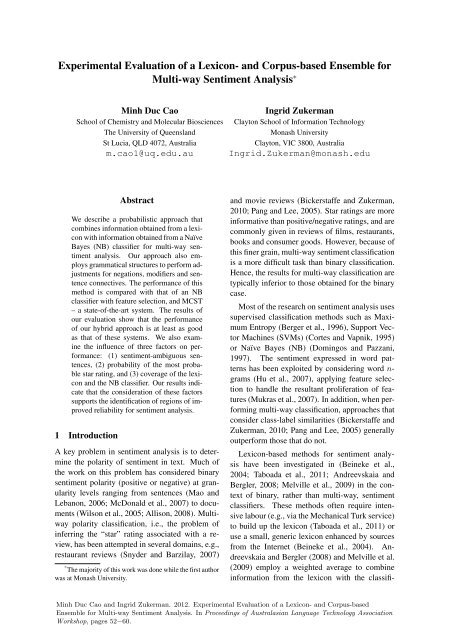Full proceedings volume - Australasian Language Technology ...
Full proceedings volume - Australasian Language Technology ...
Full proceedings volume - Australasian Language Technology ...
Create successful ePaper yourself
Turn your PDF publications into a flip-book with our unique Google optimized e-Paper software.
Experimental Evaluation of a Lexicon- and Corpus-based Ensemble for<br />
Multi-way Sentiment Analysis ∗<br />
Minh Duc Cao<br />
School of Chemistry and Molecular Biosciences<br />
The University of Queensland<br />
St Lucia, QLD 4072, Australia<br />
m.cao1@uq.edu.au<br />
Ingrid Zukerman<br />
Clayton School of Information <strong>Technology</strong><br />
Monash University<br />
Clayton, VIC 3800, Australia<br />
Ingrid.Zukerman@monash.edu<br />
Abstract<br />
We describe a probabilistic approach that<br />
combines information obtained from a lexicon<br />
with information obtained from a Naïve<br />
Bayes (NB) classifier for multi-way sentiment<br />
analysis. Our approach also employs<br />
grammatical structures to perform adjustments<br />
for negations, modifiers and sentence<br />
connectives. The performance of this<br />
method is compared with that of an NB<br />
classifier with feature selection, and MCST<br />
– a state-of-the-art system. The results of<br />
our evaluation show that the performance<br />
of our hybrid approach is at least as good<br />
as that of these systems. We also examine<br />
the influence of three factors on performance:<br />
(1) sentiment-ambiguous sentences,<br />
(2) probability of the most probable<br />
star rating, and (3) coverage of the lexicon<br />
and the NB classifier. Our results indicate<br />
that the consideration of these factors<br />
supports the identification of regions of improved<br />
reliability for sentiment analysis.<br />
1 Introduction<br />
A key problem in sentiment analysis is to determine<br />
the polarity of sentiment in text. Much of<br />
the work on this problem has considered binary<br />
sentiment polarity (positive or negative) at granularity<br />
levels ranging from sentences (Mao and<br />
Lebanon, 2006; McDonald et al., 2007) to documents<br />
(Wilson et al., 2005; Allison, 2008). Multiway<br />
polarity classification, i.e., the problem of<br />
inferring the “star” rating associated with a review,<br />
has been attempted in several domains, e.g.,<br />
restaurant reviews (Snyder and Barzilay, 2007)<br />
* The majority of this work was done while the first author<br />
was at Monash University.<br />
and movie reviews (Bickerstaffe and Zukerman,<br />
2010; Pang and Lee, 2005). Star ratings are more<br />
informative than positive/negative ratings, and are<br />
commonly given in reviews of films, restaurants,<br />
books and consumer goods. However, because of<br />
this finer grain, multi-way sentiment classification<br />
is a more difficult task than binary classification.<br />
Hence, the results for multi-way classification are<br />
typically inferior to those obtained for the binary<br />
case.<br />
Most of the research on sentiment analysis uses<br />
supervised classification methods such as Maximum<br />
Entropy (Berger et al., 1996), Support Vector<br />
Machines (SVMs) (Cortes and Vapnik, 1995)<br />
or Naïve Bayes (NB) (Domingos and Pazzani,<br />
1997). The sentiment expressed in word patterns<br />
has been exploited by considering word n-<br />
grams (Hu et al., 2007), applying feature selection<br />
to handle the resultant proliferation of features<br />
(Mukras et al., 2007). In addition, when performing<br />
multi-way classification, approaches that<br />
consider class-label similarities (Bickerstaffe and<br />
Zukerman, 2010; Pang and Lee, 2005) generally<br />
outperform those that do not.<br />
Lexicon-based methods for sentiment analysis<br />
have been investigated in (Beineke et al.,<br />
2004; Taboada et al., 2011; Andreevskaia and<br />
Bergler, 2008; Melville et al., 2009) in the context<br />
of binary, rather than multi-way, sentiment<br />
classifiers. These methods often require intensive<br />
labour (e.g., via the Mechanical Turk service)<br />
to build up the lexicon (Taboada et al., 2011) or<br />
use a small, generic lexicon enhanced by sources<br />
from the Internet (Beineke et al., 2004). Andreevskaia<br />
and Bergler (2008) and Melville et al.<br />
(2009) employ a weighted average to combine<br />
information from the lexicon with the classifi-<br />
Minh Duc Cao and Ingrid Zukerman. 2012. Experimental Evaluation of a Lexicon- and Corpus-based<br />
Ensemble for Multi-way Sentiment Analysis. In Proceedings of <strong>Australasian</strong> <strong>Language</strong> <strong>Technology</strong> Association<br />
Workshop, pages 52−60.














